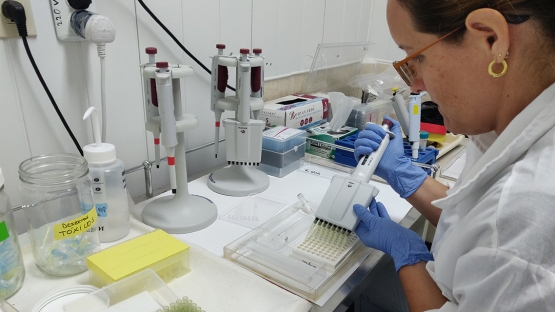The first laboratory in Latin America and the Caribbean to be able to detect ciguatoxins, the toxins responsible for the most significant non-bacterial seafood poisoning, recently became fully operational in Cuba, the result of close cooperation between the IAEA and local partners. Naturally occurring, ciguatoxins are responsible for ciguatera poisoning, responsible for tens of thousands of seafood poisoning cases every year. The new lab will provide analytical services to other countries in the region as well.
To address the ciguatoxin problem, the IAEA has been building capacity for ciguatera monitoring in the region through the use of nuclear and isotopic techniques.
“Ciguatera toxins have been a major problem in Latin America and the Caribbean for years, and now we have become the first laboratory in the region capable of monitoring ciguatera toxins on-site through the use of nuclear techniques,” said Carlos Alonso-Hernandez, Vice Director at the Centre of Environmental Studies of Cienfuegos (CEAC). “From our training in nuclear techniques, we can contribute to robust seafood safety programmes that are crucial for the health and well-being of our region, not to mention the economy.”
Ciguatoxins are one of the many naturally occurring biotoxins associated with harmful algal blooms (HABs). Microscopic algae, which are at the base of the marine food chain, provide a vital source of nutrients for marine organisms and produce more than half the earth’s oxygen supply. However, factors such as coastal upwelling or agricultural run-off can increase nutrient levels in water and can cause algal blooms, which in some cases produce biotoxins like ciguatoxin. Every year, HABs, also known as red tides, are responsible for tens of thousands of poisoning incidents all over the globe due to the consumption of contaminated seafood. Symptoms can include vomiting, diarrhoea, dizziness or, in extreme cases, even death as well as respiratory issues in people who breathe in toxic aerosols.
Nuclear techniques can quickly identify biotoxins in seafood and in the environment and pinpoint these outbreaks more accurately than other methods. To this end, IAEA researchers have been training scientists in close to 40 countries, including Cuba, on the use of a key nuclear tool—the radioligand receptor binding assay (RBA)—and much more. From assistance in procurement, to training in sampling techniques for controlling the presence of toxic algal species, to preparing the samples, the journey that scientists in Cuba have taken will create an impact even beyond their country, Alonso-Hernandez said. The laboratory in Cuba is now fully operational to detect ciguatoxins in samples received from other laboratories in Latin America.
The path to success mirrors the applications of RBA for other biotoxins in El Salvador, Morocco, Oman, the Philippines and Tunisia. The technique is based on the specific interaction between the toxins and the receptor they bind (pharmacological target), in which a radiolabelled toxin competes for a limited number of receptor binding sites with the toxin in the sample being analysed, allowing quantification of the toxicity of the sample. The IAEA has also developed other analytical methods to measure biotoxins and study how they are taken up by marine organisms and transferred up the food chain.
“Outbreaks of HABs that produce ciguatoxins used to be limited to tropical and subtropical regions, but new endemic regions are emerging while expansion of the international seafood trade is also spreading the risks of seafood contamination,” said Marie-Yasmine Dechraoui Bottein, a research scientist at the IAEA Environment Laboratories in Monaco. Indeed, the issue of HABs is one of increasing global importance, especially since its increase has been linked to climate change. The IAEA is working on an interagency strategy to address ciguatoxins through a multi-disciplinary approach, along with the World Health Organization (WHO), the Food and Agricultural Organization (FAO) and the Intergovernmental Oceanographic Commission of the United Nations Educational, Scientific and Cultural Organization (IOC-UNESCO).
The IAEA Environment Laboratories’ work in Cuba is part of a larger technical cooperation project in the Caribbean on strengthening regional monitoring and response for sustainable marine and coastal environments.





